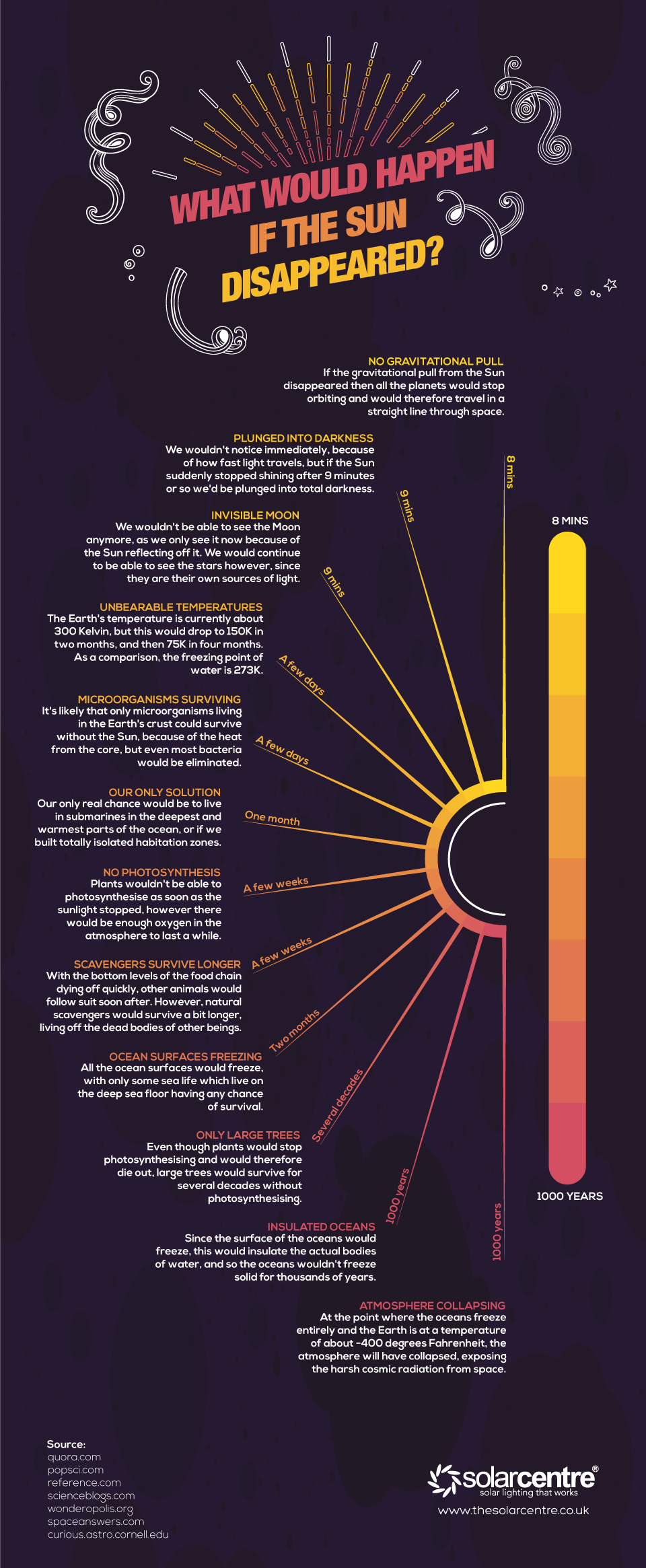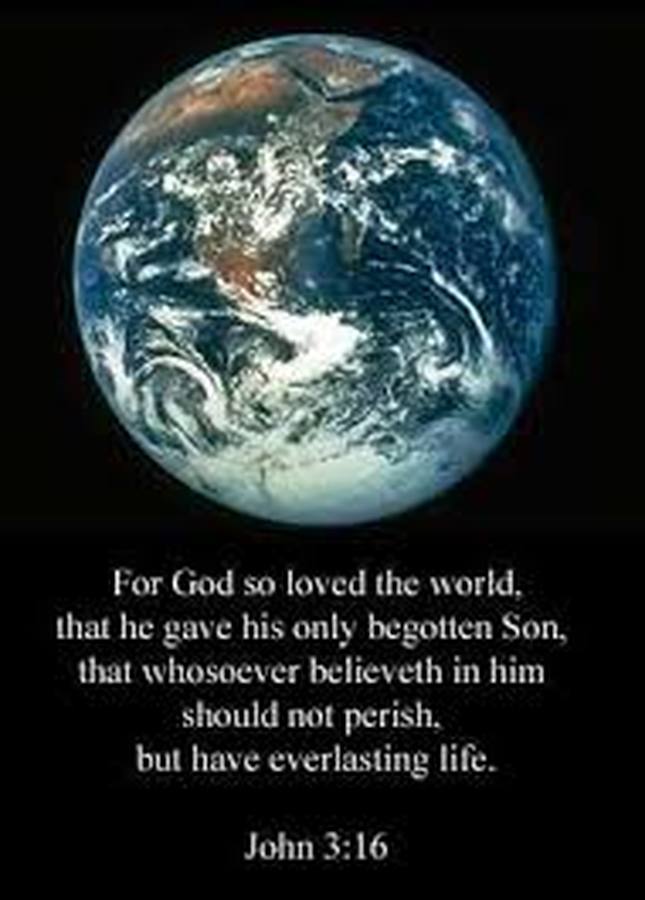THIS SITE IS UPDATED OFTEN TO HELP YOU FIND YOUR WAY AROUND THE COSMOS.
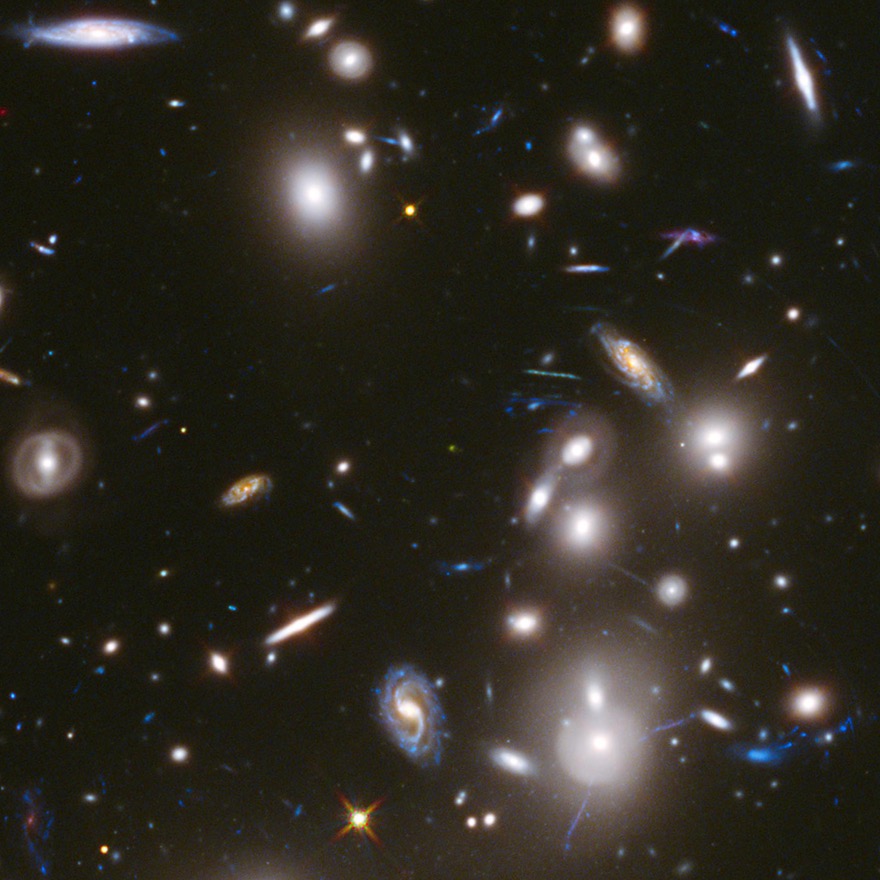
This is a giant galaxy cluster known as Abell 2744, aka Pandora's Cluster, located in the direction of the constellation Sculptor. The cluster is about 4 million light-years across and has the mass of 4 trillion suns. It appears to be the result of a simultaneous pile-up of at least 4 separate, smaller galaxy clusters that took place over a span of 350 million years. Image via NASA/ ESA/ J. Lotz/ M. Mountain/ A. Koekemoer/ Hubble Frontier Fields Team.
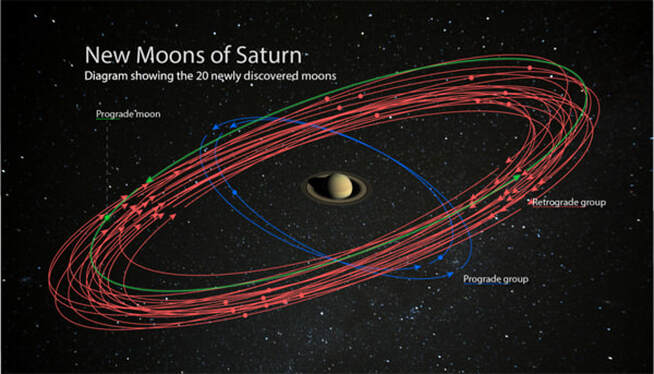 Jupiter may be the king of the planets, but — right now, at least — Saturn is the king of moons. Astronomers Scott Sheppard (Carnegie Institution for Science), David Jewitt (UCLA), and Jan Kleyna (University of Hawai‘i) have announced the discovery of 20 new moons circling the ringed planet, putting Saturn’s total at 82 compared to Jupiter’s 79. The moons are each around 5 kilometers (3 miles) in diameter.
The team used the Subaru telescope atop Maunakea, Hawai‘i, to find the moons. Sheppard had previously led a team in discovering of 10 new moons around Jupiter, announced last year, using the 6.5-m Magellan-Baade reflector Las Campanas and the 4.0-m Blanco reflector on Cerro Tololo.
Jupiter may be the king of the planets, but — right now, at least — Saturn is the king of moons. Astronomers Scott Sheppard (Carnegie Institution for Science), David Jewitt (UCLA), and Jan Kleyna (University of Hawai‘i) have announced the discovery of 20 new moons circling the ringed planet, putting Saturn’s total at 82 compared to Jupiter’s 79. The moons are each around 5 kilometers (3 miles) in diameter.
The team used the Subaru telescope atop Maunakea, Hawai‘i, to find the moons. Sheppard had previously led a team in discovering of 10 new moons around Jupiter, announced last year, using the 6.5-m Magellan-Baade reflector Las Campanas and the 4.0-m Blanco reflector on Cerro Tololo.
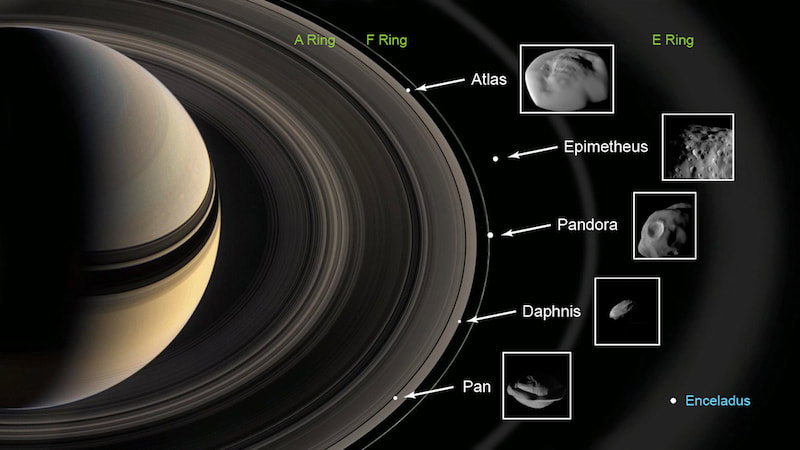
New findings have emerged about five tiny moons nestled in and near Saturn’s rings. Super-close flybys by NASA’s Cassini spacecraft – which orbited Saturn from 2004 to 2017 – reveal that the surfaces of these unusual moons are covered with material from the planet’s rings – and from icy particles blasting out of Saturn’s larger moon Enceladus.
Planet Saturn has 62 moons, ranging in size from tiny moonlets less than .6 miles (1 kilometer) across to the enormous Titan, which is larger than the planet Mercury. The five moons inspected by Cassini were Atlas, Epimetheus, Pandora, Daphnis and Pan.
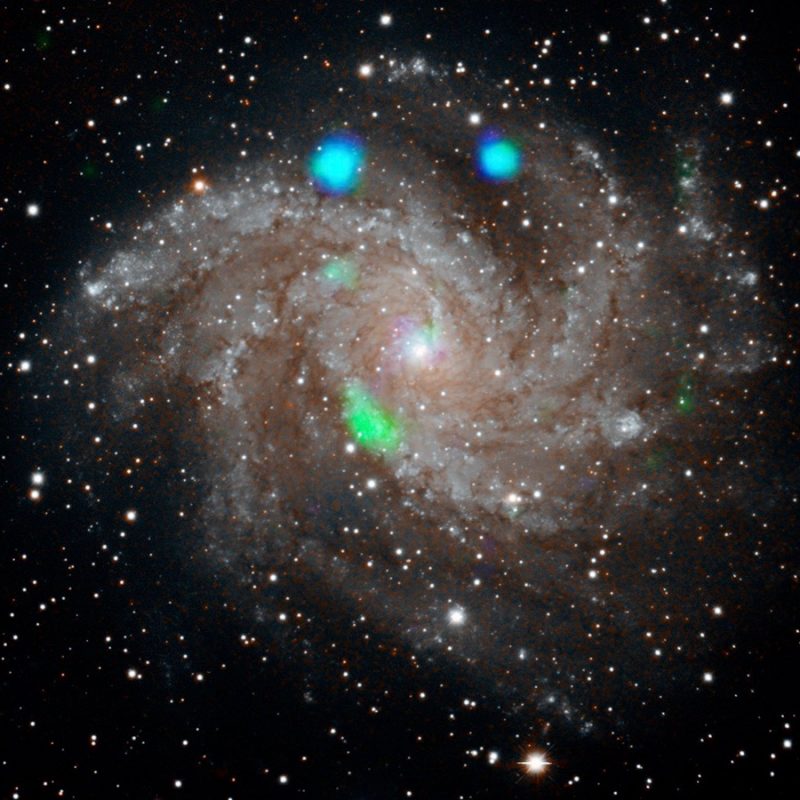
This visible-light image of the Fireworks Galaxy (NGC 6946) comes from the Sloan Digital Sky Survey. It’s overlaid with data from NASA’s NuSTAR X-ray telescope (in blue and green). The mystery green blob is toward the middle of the galaxy, apparently coincident with one of its spiral arms. Image via NASA/JPL-Caltech.
The universe is full of mysteries, and now there’s a new one for astronomers to puzzle over. A space-based X-ray observatory – NASA’s NuSTAR – saw what astronomers described as a green blob in the galaxy known as NGC 6946, aka the Fireworks Galaxy. The blob appeared within a 10-day period and then disappeared again just as quickly.
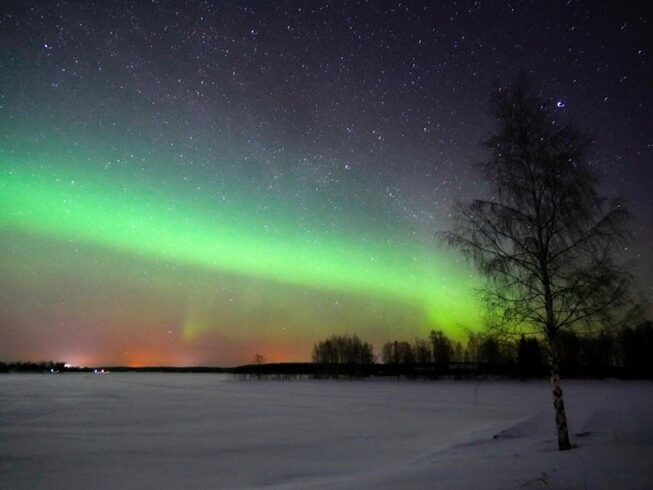
By Nathan Case, Lancaster University
Like most planets in our solar system, the Earth has its own magnetic field. Thanks to its largely molten iron core, our planet is in fact a bit like a bar magnet. It has a north and south magnetic pole, separate from the geographic poles, with a field connecting the two. This field protects our planet from radiation and is responsible for creating the northern and southern lights – spectacular events that are only visible near the magnetic poles.
However, with reports that the magnetic north pole has started moving swiftly at 50km (31 miles) per year – and may soon be over Siberia – it has long been unclear whether the northern lights will move too. Now a new study, published in Geophysical Research Letters, has come up with an answer.
Our planetary magnetic field has many advantages. For over 2,000 years, travellers have been able to use it to navigate across the globe. Some animals even seem to be able to find their way thanks to the magnetic field. But, more importantly than that, our geomagnetic field helps protect all life on Earth.
Earth’s magnetic field extends hundreds of thousands of kilometers out from the center of our planet – stretching right out into interplanetary space, forming what scientists call a “magnetosphere”. This magnetosphere helps to deflect solar radiation and cosmic rays, preventing the destruction of our atmosphere. This protective magnetic bubble isn’t perfect though, and some solar matter and energy can transfer into our magnetosphere. As it is then funneled into the poles by the field, it results in the spectacular displays of the northern lights.
A wandering pole
Since Earth’s magnetic field is created by its moving, molten iron core, its poles aren’t stationary and they wander independently of one another. In fact, since its first formal discovery in 1831, the north magnetic pole has travelled over 1,240 miles (2,000 km) from the Boothia Peninsula in the far north of Canada to high in the Arctic Sea. This wandering has generally been quite slow, around 9km (6 mi) a year, allowing scientists to easily keep track of its position. But since the turn of the century, this speed has increased to 30 miles (50 km) a year. The south magnetic pole is also moving, though at a much slower rate (6-9 miles, or 10-15 km a year).
This rapid wandering of the north magnetic pole has caused some problems for scientists and navigators alike. Computer models of where the north magnetic pole might be in the future have become seriously outdated, making accurate compass-based navigation difficult. Although GPS does work, it can sometimes be unreliable in the polar regions. In fact, the pole is moving so quickly that scientists responsible for mapping the Earth’s magnetic field were recently forced to update their model much earlier than expected.
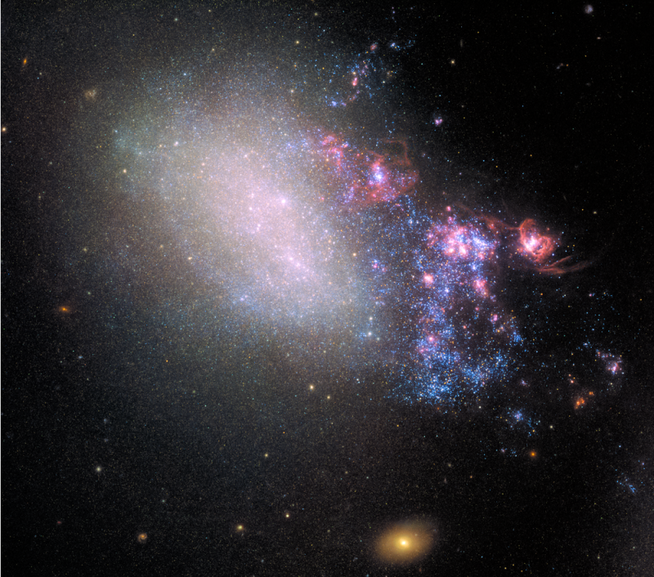
The Hubble Space Telescope’s Wide Field Camera 3 (WFC3) and Advanced Camera for Surveys (ACS) captured this image of irregular galaxy NGC 4485. The young blue stars and star-incubating pinkish nebulas on its right side indicate active star formation, caused by a close encounter with another galaxy. Meanwhile, on its left side, you can see hints of the galaxy’s earlier spiral structure. Image via NASA/ESA/HubbleSite.
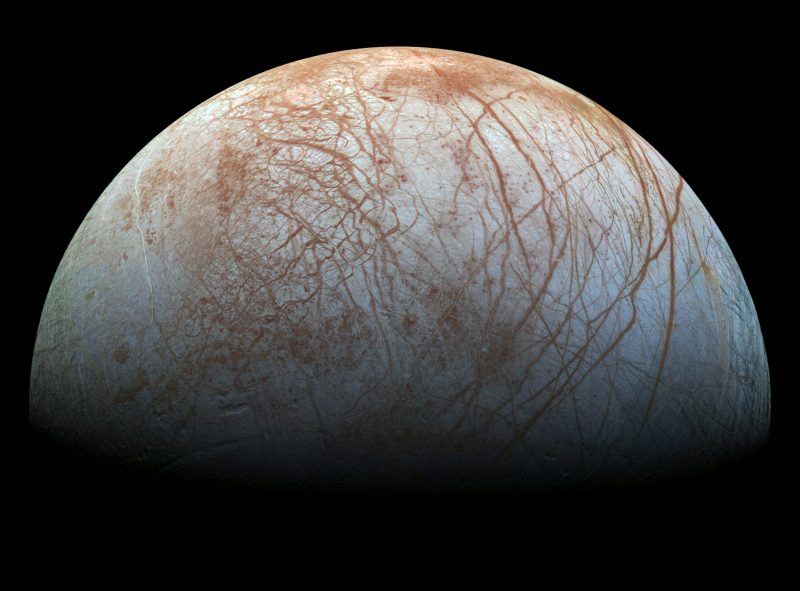
Like Earth, Jupiter’s moon Europa is believed to be a water world. Scientists have strong evidence that a global subsurface ocean lies beneath Europa’s outer icy surface crust. From what we know so far, this marine environment isn’t too different from what exists in Earth’s oceans. There’s a rocky bottom and possible hydrothermal vents much like those found on ocean floors on our planet.
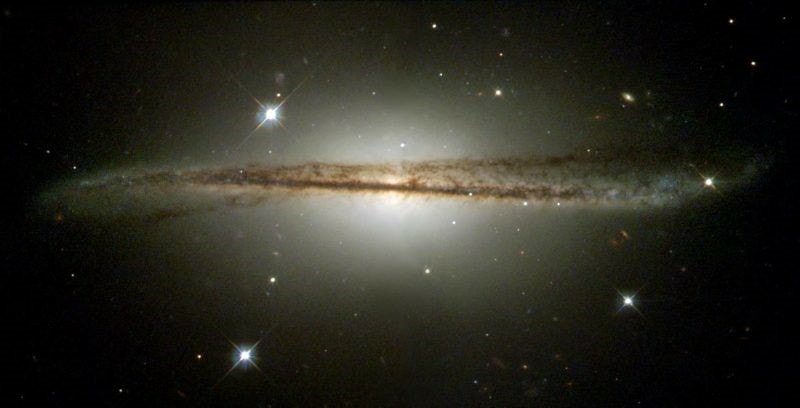
We think of spiral galaxies as being flat. You often hear the disk of our galaxy described as “flat as a pancake.” The large spiral galaxy next door – the Andromeda galaxy – looks flat through a telescope. But nature can be intricate, and, this week (February 4, 2019), astronomers made a surprising announcement. They said our home galaxy, the Milky Way, isn’t flat. Instead it’s warped and twisted.
Astronomers from Macquarie University and the Chinese Academy of Sciences used 1,339 classical Cepheid variable stars for this study. They are stars that brighten and dim in a way that changes according to the stars’ true luminosities. Thus these stars have been used as classic distance indicators. The astronomers used data on these stars from the Wide-field Infrared Survey Explorer (WISE). The work led them to create a 3D map of what they said is the “real” shape of our Milky Way. A paper describing this study was published February 4 in the peer-reviewed journal Nature Astronomy. The astronomers’ statement said:
They found the Milky Way’s disk of stars becomes increasingly ‘warped’ and twisted the further away the stars are from the galaxy’s center.
Astronomers don’t like to think of our Milky Way as being in any way “special.” But – from what’s known today – its twisted shape does give it a specialness, although not a uniqueness. Astronomers have observed a dozen other galaxies that showed similarly twisted spiral patterns in their outer regions.
So our Milky Way’s twists are rare, but not unobserved elsewhere in the universe.
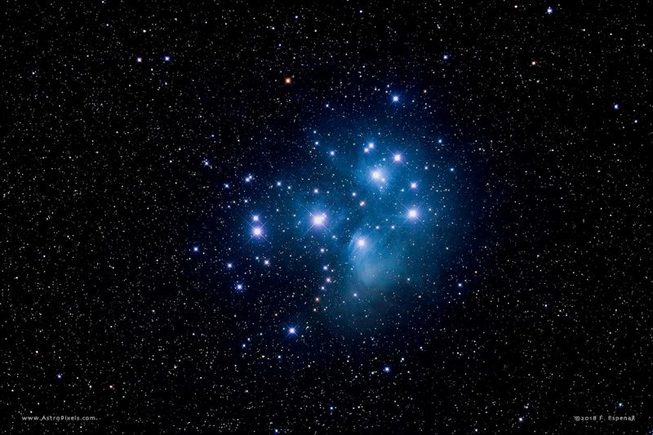
The Pleiades star cluster – also known as the Seven Sisters or M45 – is visible from virtually every part of the globe. It can be seen from as far north as the North Pole, and farther south than the southernmost tip of South America. It looks like a tiny misty dipper of stars.
If you’re familiar with the famous constellation Orion, it can help you be sure you’ve found the Pleiades. See the three stars in a row in Orion? That’s Orion’s Belt. Draw a line through these stars to the V-shaped pattern of stars with a bright star in its midst. The V-shaped pattern is the Face of Taurus the Bull. The bright star in the V – called Aldebaran – depicts the Bull’s Eye. A bit past Aldebaran, you’ll see the Pleiades cluster, which marks the Bull’s Shoulder.
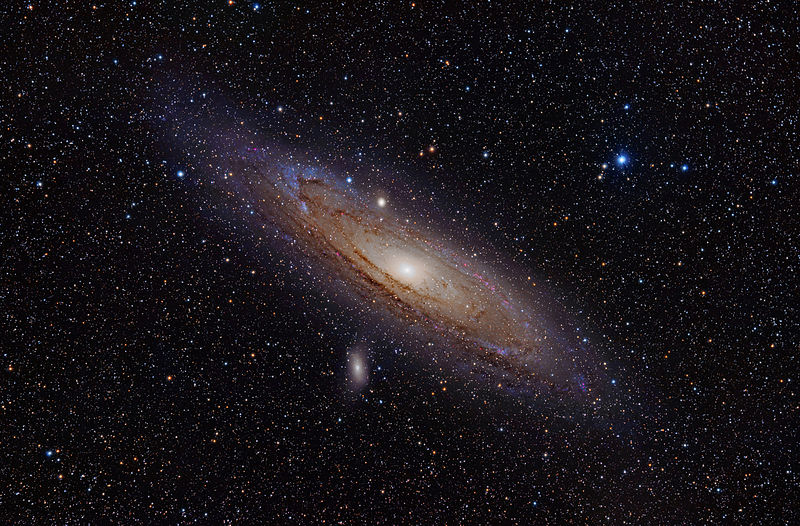
Although several dozen minor galaxies lie closer to our Milky Way, the Andromeda galaxy is the closest large spiral galaxy to ours. Excluding the Large and Small Magellanic Clouds, which can’t be seen from northerly latitudes, the Andromeda galaxy – also known as M31 – is the brightest galaxy you can see. At 2.5 million light-years, it’s also the most distant thing visible to your unaided eye.
To the eye, this galaxy appears as a smudge of light larger than a full moon.
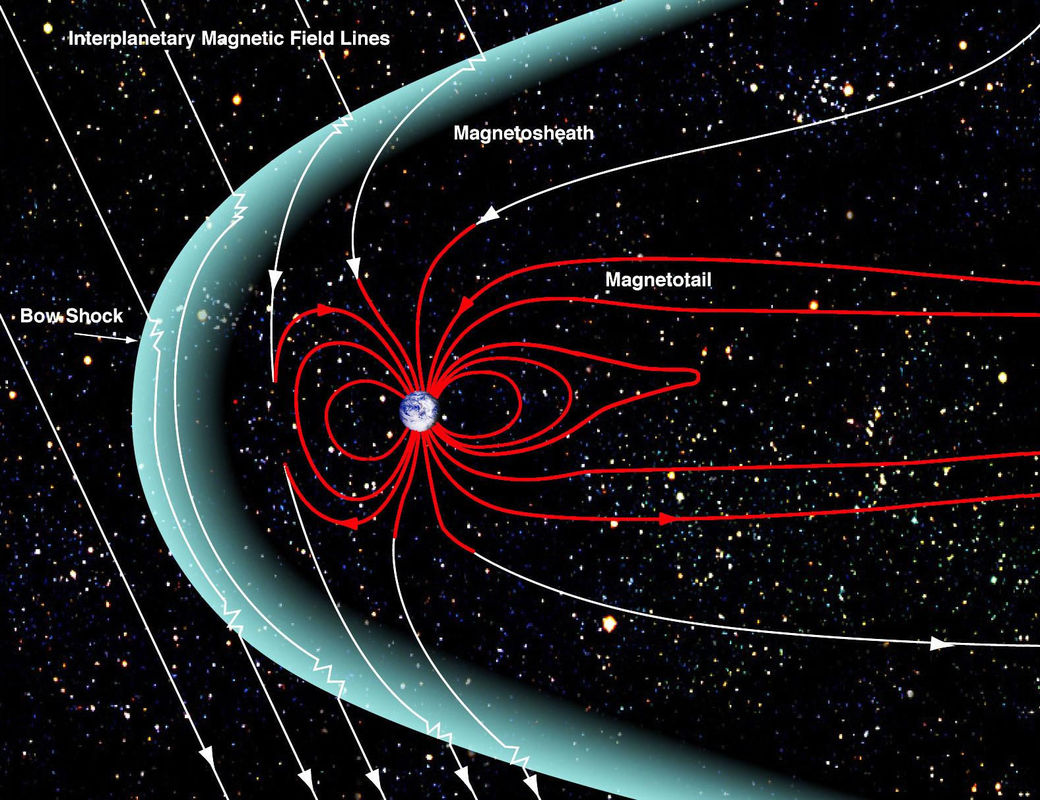
A magnetosphere is that area of space, around a planet, that is controlled by the planet's magnetic field. The shape of the Earth's magnetosphere is the direct result of being blasted by solar wind. The solar wind compresses its sunward side to a distance of only 6 to 10 times the radius of the Earth. A supersonic shock wave is created sunward of Earth called the Bow Shock. Most of the solar wind particles are heated and slowed at the bow shock and detour around the Earth in the Magnetosheath. The solar wind drags out the night-side magnetosphere to possibly 1000 times Earth's radius; its exact length is not known. This extension of the magnetosphere is known as the Magnetotail. The outer boundary of Earth's confined geomagnetic field is called the Magnetopause. The Earth's magnetosphere is a highly dynamic structure that responds dramatically to solar variations.
Credit: NASA/Goddard/Aaron Kaase
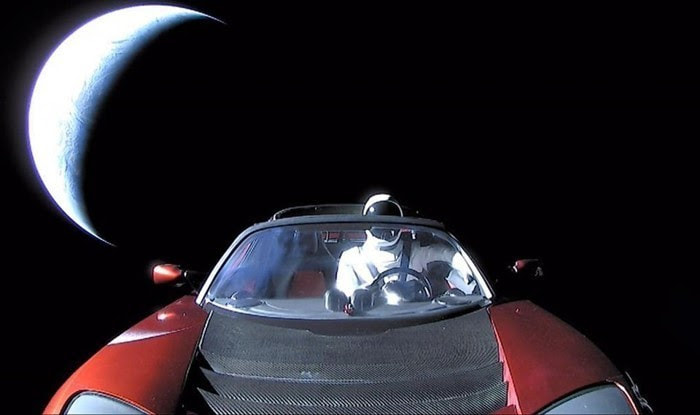
A camera mounted ahead caught this image of Starman, in Elon Musk’s red Tesla Roadster, as car and mannequin left Earth behind. Calculations by astronomers in the days after the launch suggest the payload reached a speed of 20.8 miles per second (33.5 km/sec) after the last burn, a faster speed than expected. Image via SpaceX. Last Tuesday (February 6, 2018), SpaceX’s Falcon Heavy successfully lifted off from Launch Complex 39A at Kennedy Space Center in Florida. Falcon Heavy is now the world’s most powerful operational rocket by a factor of two, providing a heavy-lift capability not seen since the Apollo era in the late 1960s and early ’70s, when mighty Saturn V rockets lifted astronauts to the moon. Falcon Heavy’s launch last Tuesday was a test flight, its maiden voyage, meant to prove the concept of the rocket itself (which is in essence three of SpaceX’s Falcon 9 rockets joined together). It definitely did! But SpaceX founder and CEO Elon Musk, as always, went further. He and his team placed Musk’s 2008 Tesla Roadster at the top of the rocket, with the goal of blasting it into an elliptical orbit between Earth and Mars. The orbit would, at times, bring the car – with its passenger, a mannequin nicknamed Starman, dressed for space – near Mars.
The Falcon Heavy rocket test was a major success and a thrill for space fans. After livestreaming views from StarMan’s vantage point in Earth orbit SpaceX reignited the upper stage’s engine one last time, giving the Tesla a push beyond Earth’s orbit.
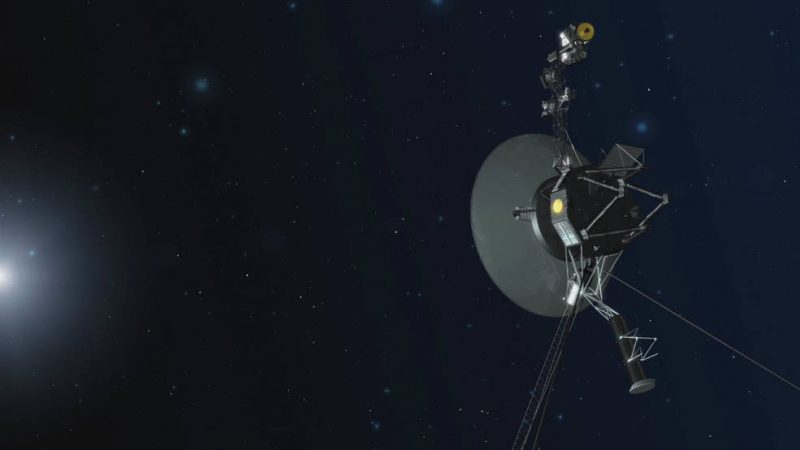
Humanity’s farthest and longest-lived spacecraft, Voyager 1 and 2, achieve 40 years of operation and exploration this August and September. Despite their vast distance, they continue to communicate with NASA daily, still probing the final frontier.
Their story has not only impacted generations of current and future scientists and engineers, but also Earth’s culture, including film, art and music. Each spacecraft carries a Golden Record of Earth sounds, pictures and messages. Since the spacecraft could last billions of years, these circular time capsules could one day be the only traces of human civilization.
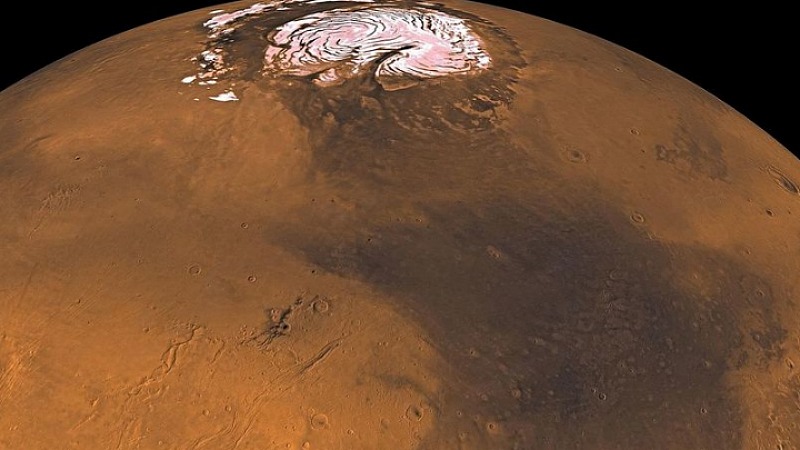
Mars seen by the Viking oriter. Image via NASA/JPL/USGS
By Andrew Coates, UCL
Europe has been trying to land on Mars since 2003, but none of the attempts have gone exactly according to plan. A couple of months ago, the ExoMars Schiaparelli landing demonstrator crashed onto the planet’s surface, losing contact with its mothership. However, the mission was partially successful, providing information that will enable Europe and Russia to land its ExoMars rover on the Red Planet in 2021.
Now European research ministers have finally agreed to give the mission the outstanding €400m it needs to go ahead. A lot is at stake as the rover is poised to uniquely drill under the harsh Martian surface to search for signs of past, or even present, life. With the best of human endeavor, we must learn, try again and not give up. As leader of the international Panoramic Camera team on the rover, which will among other things provide surface geological and atmospheric context for the mission, I am one of many scientists working very hard to make it work. PanCam is one of nine state-of-the-art instruments which will help us analyze subsurface samples.
The reason it is so hard to land on Mars is that the atmospheric pressure is low, less than 1% of Earth’s surface pressure. This means that any probe will descend very rapidly to the surface, and must be slowed. What’s more, the landing has to be done autonomously as the light travel time from Earth is three to 22 minutes. This delay transmission means we can’t steer the rapid process from Earth. NASA and Russia have had their own problems with landings in the past, before the spectacular successes with the US missions Viking, Pathfinder, Spirit,Opportunity, Phoenix and Curiosity
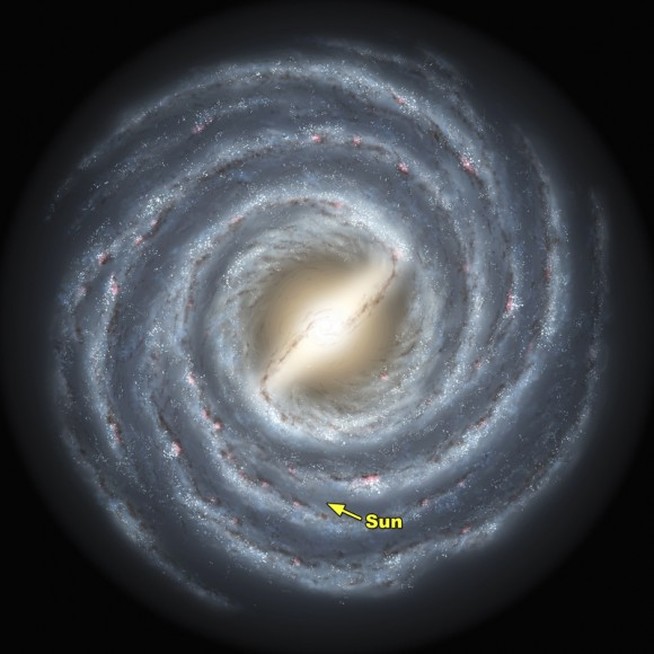
Our sun is located about two-thirds of the way out from the center of the Milky Way. Illustration via Caltech.
The planets in our solar system orbit around the sun. One orbit of the Earth takes one year. Meanwhile, our entire solar system – our sun with its family of planets, moon, asteroid and comets – orbits the center of the Milky Way galaxy. Our sun and solar system move at about about 500,000 miles an hour (800,000 km/hr) in this huge orbit. So in 90 seconds, for example, we all move some 12,500 miles (20,000 km) in orbit around the galaxy’s center.
Our Milky Way galaxy is a big place. Even at this blazing speed, it takes the sun approximately 225-250 million years to complete one journey around the galaxy’s center.
This amount of time – the time it takes us to orbit the center of the galaxy – is sometimes called a cosmic year.
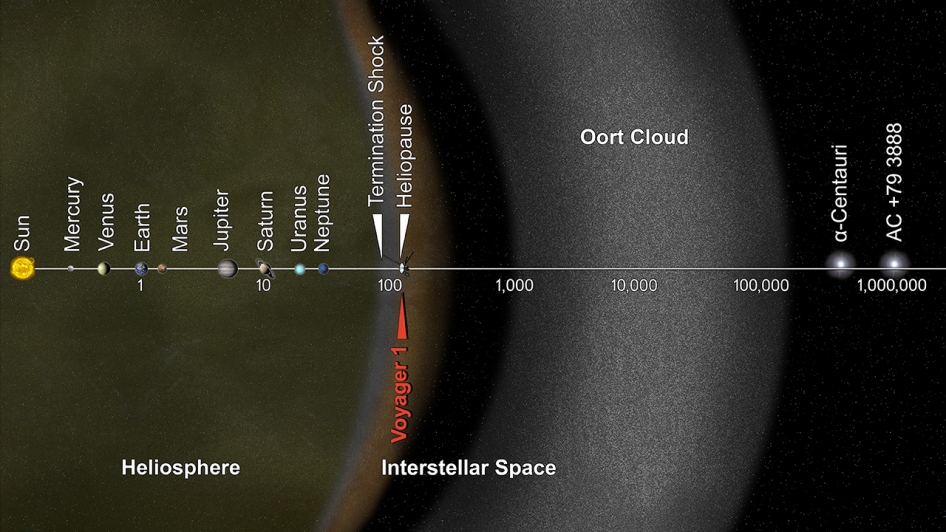
This artist’s concept puts solar system distances in perspective, but you have to think about it a bit to understand it. The scale bar is in astronomical units (AU), with each set distance beyond 1 AU representing 10 times the previous distance. One AU is the distance from the sun to the Earth, by the way, which is about 93 million miles or 150 million kilometers. Neptune, the most distant planet from the sun, is about 30 AU.
Informally, the term solar system is often used to mean the space surrounding our sun, out to the last planet. Astronomers, however, might speak of the solar system as the heliosphere, or sphere of the sun’s influence. Our dominates its own region of space and creates a sort of bubble of charged particles in the space surrounding it. These particles are “blown” out from the sun by the solar wind. It’s this heliosphere that Voyager 1 has now left. NASA says Voyager 1 actually crossed the heliopause, the boundary around the region of the sun’s influence, over a year ago, on August 25, 2012.
It’s also possible, though, to picture the solar system as going out to the Oort Cloud, the source of the comets that swing by our sun on long time scales. Beyond the outer edge of the Oort Cloud, the sun’s gravitational influence begins to wane. The inner edge of the main part of the Oort Cloud could be as close as 1,000 AU from our sun. The outer edge is estimated to be around 100,000 AU. So that’s 100,000 times the Earth-sun distance.
